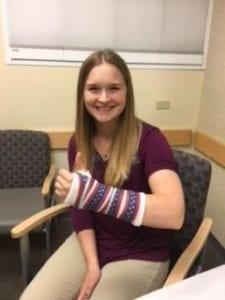Caring for your cast
- posted: Jul. 03, 2018
A bone can break if the external force is greater than the strength of the bone.The most common way to evaluate a fracture is with x-rays, which provide clear images of the bones. A fracture can heal successfully if the ends of the break at the fracture site are realigned and immobilized so that new bone healing can take place. A plaster or fiberglass cast is typically used to keep the broken ends in proper position. The cast is applied over at least one joint, sometimes two joints, to limit the movement of that joint and allow the bones to heal in place. For example in a wrist fracture the cast covers the wrist joint. If the fracture is higher up the forearm the cast may need to cover the wrist and the elbow. Depending on the severity of the fracture and the age of the patient the healing time may be 6-12 weeks. Follow up X-rays will monitor correct alignment and proper healing at the fracture site.
Symptoms of many fractures include:
- painful, especially with movement
- swelling and tenderness around the injury
- bruising
- deformity – a limb may look out of place or a part of the bone may puncture through the skin
 During your recovery you will likely lose muscle strength in the injured area. Specific exercises will help you restore normal muscle strength, joint motion, and flexibility. Ask your orthopedic doctor if physical therapy can help with your recovery.
During your recovery you will likely lose muscle strength in the injured area. Specific exercises will help you restore normal muscle strength, joint motion, and flexibility. Ask your orthopedic doctor if physical therapy can help with your recovery.
Casts don’t heal broken bones on their own, they hold the affected area in place. It is very important that you also take care of your broken bone by restricting activity, keeping it clean, and eating a well balanced nutritious diet.
Do’s and Don’ts of proper cast care:
- Do not put any object inside the cast to scratch itching skin.
- Do not use powder on itching skin.
- Do not break off rough edges of your cast.
- Do keep the cast dry (unless waterproof) and clean. Use two layers of plastic to keep cast dry while showering. Use masking tape, never a rubber band.
- Do keep dirt and sand out of cast.
- Do elevate the joint and move the other joints regularly.
- Do move your injured, but swollen fingers or toes gently and often.
- Do apply ice to the cast. Place the ice in a dry plastic bag or ice pack and loosely wrap it around the cast.
- Do inspect the skin around the cast periodically. If your skin becomes red or raw around the cast, contact your doctor.
- Do inspect the cast periodically. If the cast becomes cracked or develops soft spots, or becomes lose, contact the clinic.
When to call the doctor:
- Increased pain.
- Numbness and tingling in your hand or foot.
- Burning and stinging.
- Excessive swelling that does not respond to ice and elevation.
- Loss of movement of toes or fingers.
- Fever.
- Any other concerns you may have.
If you are a patient at Missoula Bone & Joint our on-call physician is always available after hours for emergencies. Call our clinic at (406)721-4436 and the after hours operator will put you in contact with the on-call physician.
The post Caring for your cast appeared first on Missoula Bone & Joint.
